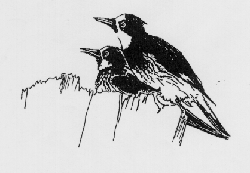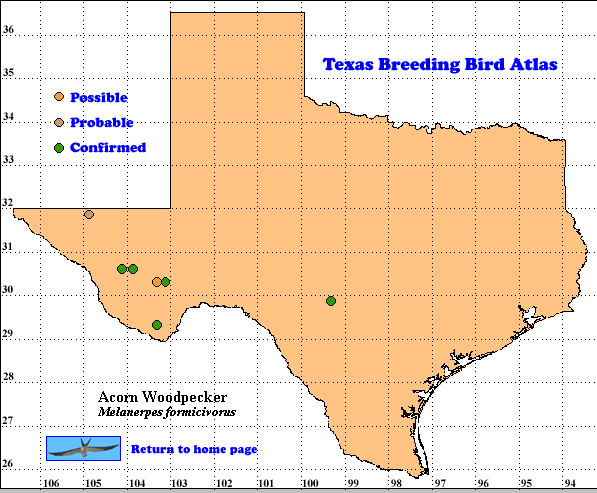Melanerpes formicivorus
The Acorn Woodpecker is a conspicuous inhabitant of foothill and montane woodlands from western Oregon, California, and the arid American Southwest (including West Texas), through Mexico and the Central American highlands to Colombia. Throughout its distribution, this woodpecker is closely associated with the presence of oaks (Quercus spp.). Large quantities of acorns are stored, protected, and consumed by these birds, making their common name quite appropriate. Where suitable habitat is found, the Acorn Woodpecker is a locally abundant species. The distinctive red, white, black, and yellow head plumage with contrasting glossy black back and parrot-like “ya-kup, ya-kup” calls make the Acorn Woodpecker easily identifiable in the field.
This species is well known for its highly social habits, frequently breeding in complex communal groups consisting of active breeders and helpers which are typically related to the breeders. The groups are somewhat loosely associated except while nesting and defending granaries (special trees used for storage of acorns). The cooperative behavior of this species has made it the focus of numerous studies of behavior and ecology, especially in California (Koenig et al. 1995).
With the exception of a few migratory populations, the Acorn Woodpecker is a year-round resident. Individuals, however, demonstrate a great capacity for long distance wandering outside of the breeding season, especially during years when local acorn crops fail. In Texas, vagrants have been found as far east as Harris County (Texas Ornithological Society 1995) and north to Potter County in the Panhandle (Oberholser 1974).
DISTRIBUTION: In Texas, TBBAP data indicated that the breeding distribution of this bird is nearly restricted to the mountains of the Trans-Pecos (Brewster, Jeff Davis, and Culbertson Counties), with the exception of one record (29099-H4) from south-central Texas which is representative of the small isolated populations of Kerr and Real Counties in the Texas Hill Country. Because a large amount of potential breeding habitat for this species in Texas is found on privately owned land, and therefore inaccessible to regular surveys, atlas data may slightly underestimate overall distribution within the state.
SEASONAL OCCURRENCE: The breeding season for Acorn Woodpeckers extends from late April to mid-August. Eggs are present in the nest by 6-18 May and young may be found in the nest to 5 August (Oberholser 1974). TBBAP data contain a total of 18 records for this species, only seven of which are confirmed nesting records. Reasons for the low number of observations are probably related to the restricted access to potential nesting habitat. Furthermore, the inaccessibility of nest cavities complicates confirmation of breeding. No NE or NY records are available in the TBBAP data base, but rather confirmation was based upon adult behavior around cavities or physiological evidence.
Dates for confirmed breeding conform to the breeding dates outlined by Oberholser (1974).
BREEDING HABITAT: This species is relatively habitat specific, in part due to the reliance on oaks which provide acorn supplies (Koenig et al. 1995). Woodlands of the mountains, hills and canyons in the Trans-Pecos region provide scattered habitat suitable for breeding (Short 1982). Selleck (1994) describes the Acorn Woodpecker as inhabiting pinyon-juniper-oak woodlands from 1500-2400 m (5000-8000 ft) and moist woodlands above 1800 m (6000 ft) in the Chisos Mountains. Associated trees of these areas include pinyon pine (Pinus cembroides), Arizona pine (Pinus strobiformis), juniper (Juniperus spp.), oaks, douglas-fir (Pseudotsuga menziesii), Texas madrone (Arbutus xalapensis), Arizona cypress (Cupressus arizonica), and other associated hardwoods (Selleck 1994). In the vicinity of Fort Davis, individuals are associated with oak woodland canyons and cottonwoods (Populus spp.) along waterway valleys. Oberholser (1974) described suitable habitat in south-central Texas as juniper-oak woodlands.
Acorn Woodpeckers excavate their own cavities for nesting which may be utilized for several consecutive years. These nest cavities are constructed at various heights in the trunks and limbs of both living and dead trees, especially favored are oaks and cottonwoods (Koenig et al. 1995). In the Chisos Mountains, nest have been recorded in oaks and pinyon pines (Wauer 1996). Man-made structures such as utility poles are also frequently used.
STATUS: The Acorn Woodpecker appears to be relatively stable in Texas. The range defined by TBBAP data is essentially the equivalent of that defined by The Bird Life of Texas (Oberholser 1974). The one exception is the confirmation of breeding in south-central Texas. Oberholser (1974) considered the Acorn Woodpecker to be a “conceivable” breeder in the Edwards Plateau, but lacked data for confirmation. Local checklists recognize this species as a common resident where appropriate habitat is found. This includes the Chisos Mountains (Selleck 1994), Davis Mountains (Espy & Williams 1991) and Guadalupe Mountains (Olsen and Flippo 1991). Rappole and Blacklock (1995) list the Acorn Woodpecker as rare in Kerr and Real counties. Breeding Bird Survey data (1966-1996) indicate no significant changes in abundance for the United States in general. Trend estimates for the state of Texas suggest some decline, but this was not significant due to small sample size (Sauer et al. 1997).
Text by Michael S. Husak (1997)
Literature cited
Espy, P. and F. Williams, compilers. 1991. Birds of the Davis Mountains State Park and vicinity: a seasonal checklist. Texas Parks and Wildlife Department, Austin.
Koenig, W.D., P.B. Stacey, M.T. Stanback, and R.L. Mumme. 1995. Acorn Woodpecker (Melanerpes formicivorus). In The birds of North America, No. 194 (A. Poole and F. Gill, eds.). The Academy of Natural Sciences, Philadelphia and The American Ornithologists’ Union, Washington D.C.
Oberholser, H.C. 1974. The bird life of Texas. University of Texas Press, Austin.
Olsen, O.V. and M. Flippo. 1991. Checklist of birds, Guadalupe Mountains National Park, Culbertson County, Texas. Carlsbad Natural History Association, Carlsbad, NM.
Rappole, J.H. and G.W. Blacklock. 1994. Birds of Texas: a field guide. Texas A&M Press, College Station, TX.
Sauer, J.R., B.G. Peterjohn, S. Schwartz, and J.E. Hines. 1996. The North American breeding bird home page. Version 95.1. Patuxent Wildlife Research Center, Laurel, MD.
Selleck, J.M. 1994. Bird checklist: Big Bend National Park, Texas, 5th revision. The Big Bend Natural History Association, Alpine, TX.
Short, L.L. 1982. Woodpeckers of the world. Delaware Mus. Nat. Hist. Monog. Ser. 4.
Texas Ornithological Society. 1995. Checklist of the birds of Texas, 3rd ed. Capital Printing, Inc., Austin.
Wauer, R.H. 1996. A field guide to birds of the Big Bend. Texas Monthly Press, Austin.

